Links are one of the top two ranking factors.
Without quality backlinks, it’s impossible to survive in the present competitive landscape.
Here’s the deal: link building is one of the hardest aspects of SEO and nearly impossible without a clear roadmap.
That’s why the first part of your campaign should include creating a link-building checklist.
Here’s what has worked for us and millions of webmasters:
Table of Contents
Before You Start Link Building
Let’s say you’ve managed to get several high-quality links from authoritative sites. But your website takes ages to load.
In this case, generating backlinks won’t be very fruitful when you have a bigger problem to solve.
Load time is essential. A site that can load in under 1 second can get 3X more conversion than a site that takes 5 seconds to load.
Therefore, before starting your link-building campaign, you must ensure your site is fully ready.
This means your website should be:
- Fast-loading
- User-friendly
Set Clear Goals
You will feel lost in the ocean of link building if you don’t have clear goals.
Your targets should be highly specific, but the gist of them could be:
- Increasing domain authority
- Driving targeted traffic
- Improving rankings for specific keywords
- Enhancing brand visibility and reputation
For example, if you aim to improve rankings for specific keywords, set a target number of high-quality backlinks you want to acquire within a certain timeframe.
Step 1: Competitor Analysis
Competitor analysis is the first step in any successful link-building strategy.
Tools like Ahrefs and SEMrush are invaluable for this task.
They allow you to analyze your competitors’ backlink profiles, identify their top-performing content, and discover which websites are linking to them.
Why Competitor Analysis is Crucial
Competitor analysis helps you:
- Identify Link Opportunities: Discover websites that are likely to link to your content.
- Understand Content Trends: Recognize which types of content are performing well in your industry.
- Benchmark Your Performance: Compare your backlink profile with your competitors to identify gaps and opportunities.
Using Ahrefs and SEMrush for Competitor Analysis
Here is how you can use two of the biggest SEO tools for competitor backlink analysis:
1. Identify Your Competitors: Use Ahrefs’ “Organic competitors” or SEMrush’s “Competitors” report to identify your main competitors. These tools list websites that are competing for the same keywords as you.
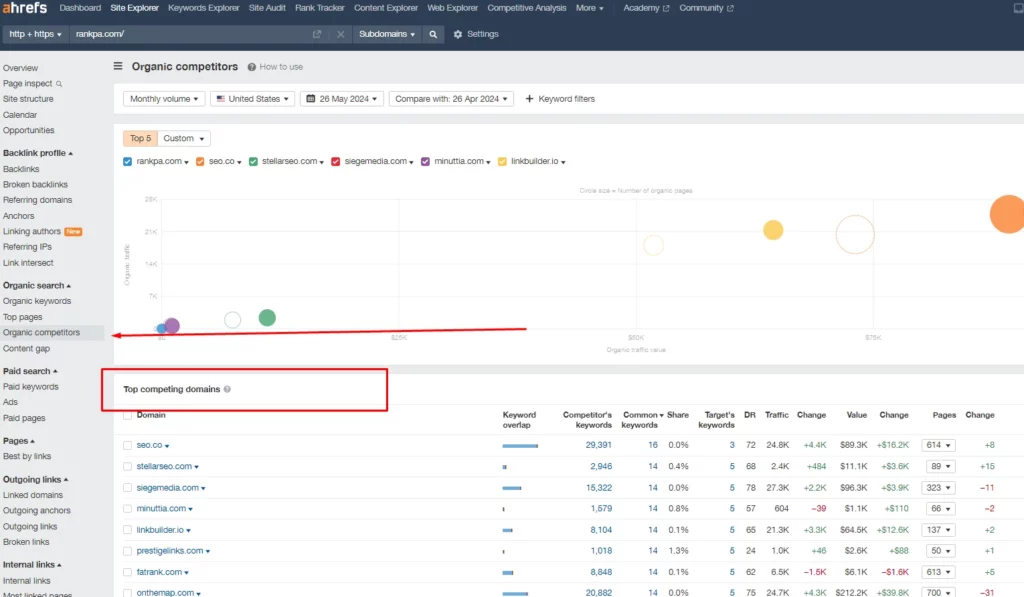
2. Analyze Competitor Backlink Profiles: Use Ahrefs’ “Site Explorer” or SEMrush’s “Backlink Analytics” to analyze your competitors’ backlink profiles. Look at:
- Total Backlinks: The total number of backlinks pointing to their site.
- Referring Domains: The number of unique domains linking to their site. A higher number of referring domains generally indicates a stronger backlink profile.
- Domain Authority (DA) or Domain Rating (DR): A metric that indicates the overall strength of a website’s backlink profile.
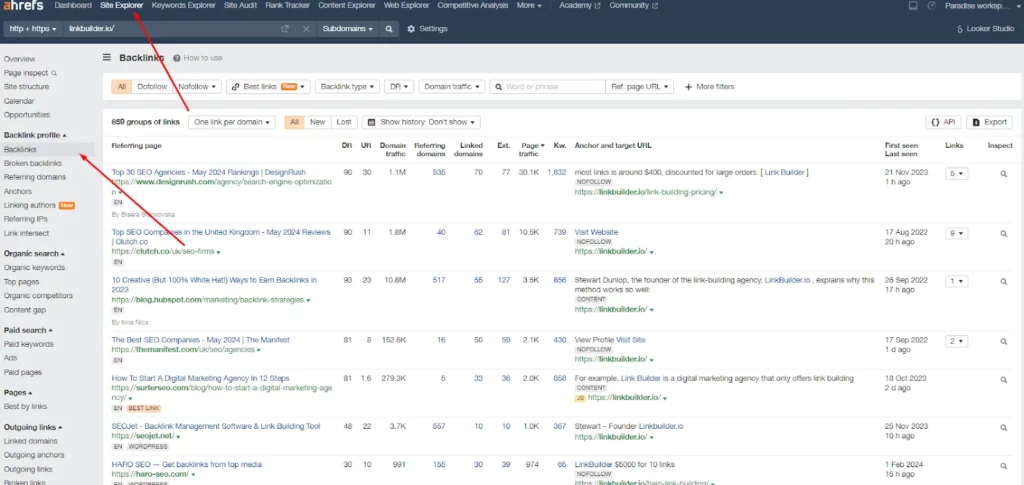
3. Identify Top-Performing Content:
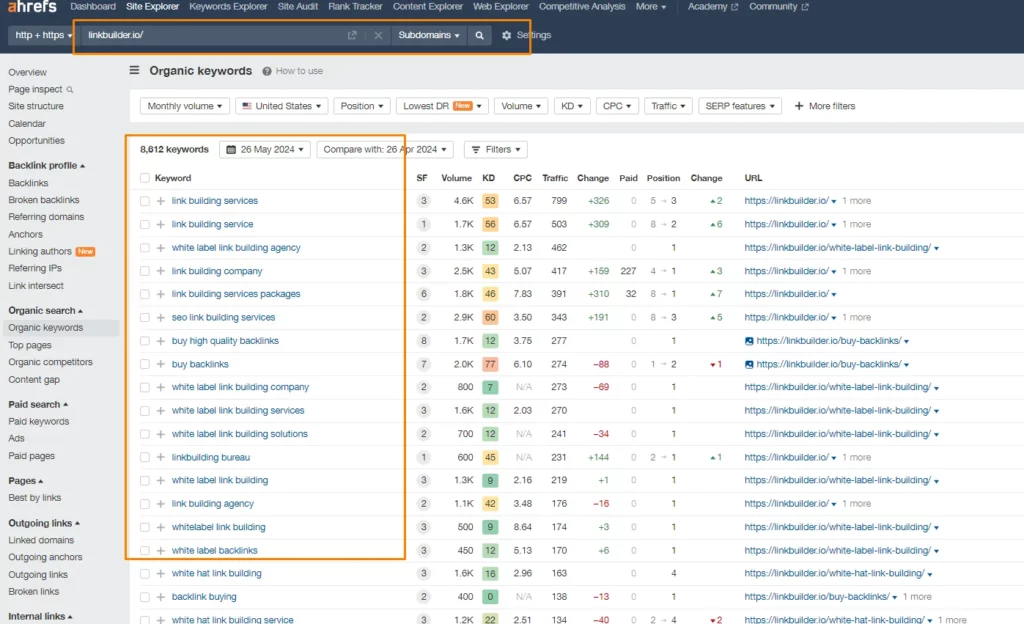
- Use Ahrefs’ or SEMrush’s “Top Pages” report to identify which pages on your competitors’ sites are attracting the most backlinks. This will help you understand which types of content are most valuable.
- Pay attention to content formats that perform well, such as blog posts, infographics, research studies, or guides.
4. Discover Linking Websites:
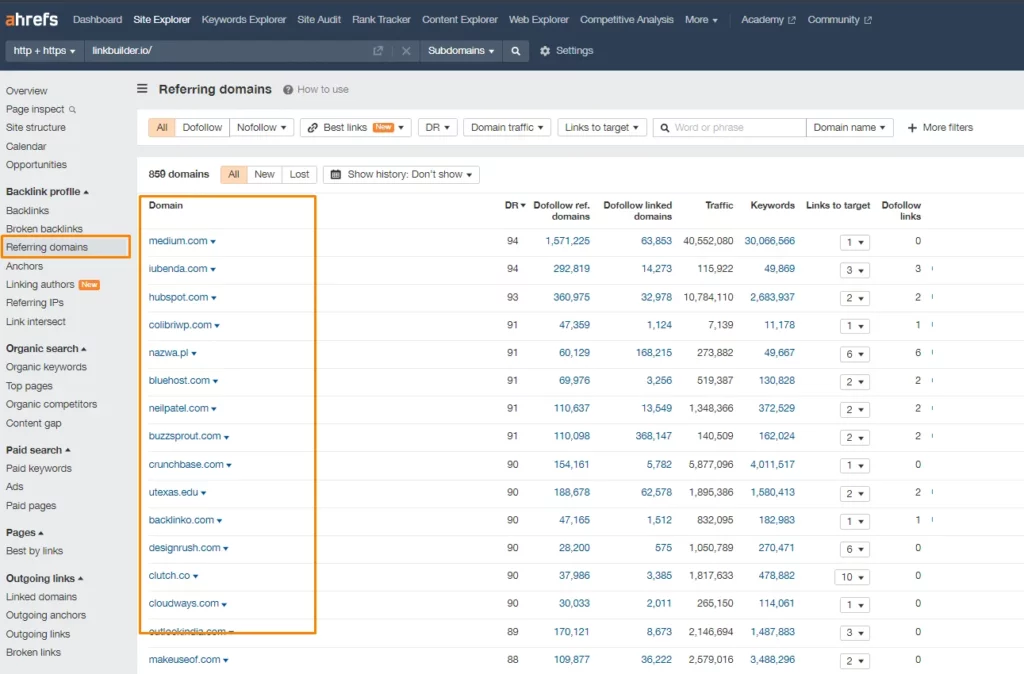
- Examine the list of websites linking to your competitors. These are potential targets for your own link building efforts. Use the “Referring Domains” report in Ahrefs or SEMrush to find these sites.
- Identify patterns in the types of websites linking to your competitors. Are they industry blogs, news sites, resource pages, or directories?
Identifying Patterns and Opportunities
Now, the purpose of doing competitor analysis is to find patterns that work.
This will help you discover link building opportunities as well.
- Content Types That Attract Links: Determine which content formats attract the most backlinks. For example, if you notice that your competitors are getting a lot of links to in-depth guides or research studies, consider creating similar high-quality content.
- Popular Topics: Identify popular topics within your niche. If certain topics are consistently attracting backlinks, creating content around these subjects can improve your chances of earning links.
- Outreach Targets: Compile a list of websites that frequently link to your competitors. We will get more into finding outreach targets in the next section.
Step 2: Finding Outreach Targets
Don’t just start randomly sending emails to anyone for links.
First, you have to find high-quality websites.
Why Do Quality Outreach Targets Matter?
High-quality backlinks from reputable websites significantly boost your site’s authority and improve search engine rankings.
Targeting the right websites ensures that the links you acquire are valuable and beneficial for your SEO efforts.
Tools for Identifying Outreach Targets
- Moz’s Link Explorer
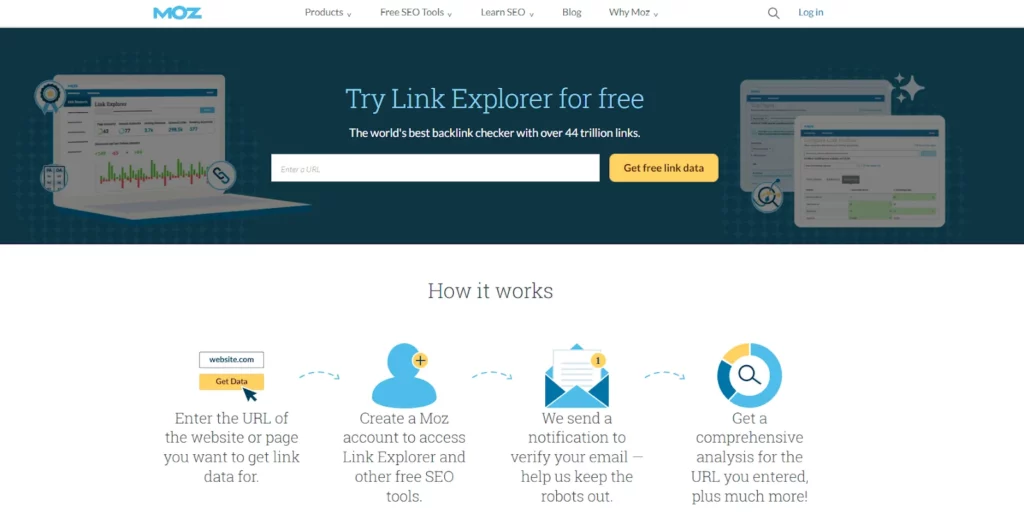
Moz’s Link Explorer is a powerful tool for discovering potential link opportunities. Use it to find websites linking to your competitors and analyze their backlink profiles.
- Ahrefs:
Ahrefs’ “Site Explorer” and “Content Explorer” are invaluable for finding relevant sites.
“Site Explorer” helps you analyze competitors’ backlinks, while “Content Explorer” allows you to find popular content in your niche, revealing who’s linking to it.
- SEMrush
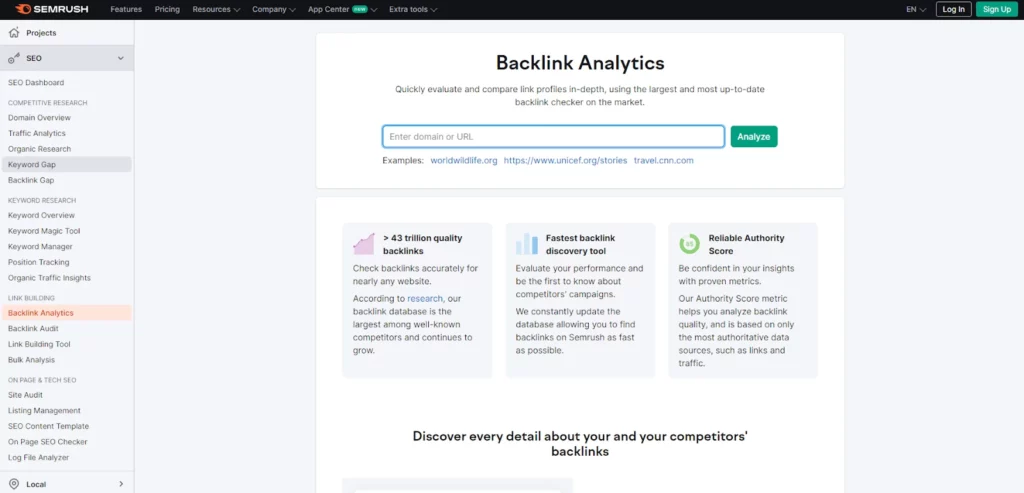
SEMrush’s “Backlink Analytics” and “Organic Research” tools help you discover top referring domains and analyze competitor strategies.
The “Backlink Gap” tool allows you to compare backlink profiles with competitors and find websites that link to them but not to you.
Finding High-Quality Outreach Targets
The first step to finding high-quality outreach targets is to determine relevance.
If you are running a website about shoes, there is no point in getting backlinks from a site that’s about computers.
The website you are getting backlinks from should be relevant to your industry.
Then, you need to assess domain authority.
Domain authority (DA) is a metric that indicates the overall strength of a website’s backlink profile. Higher DA sites typically offer more SEO value.
Use Moz’s Link Explorer, Ahrefs, or SEMrush to check the DA of potential outreach targets.
Aim for websites with a DA higher than your own, as links from these sites will likely have a greater impact on your rankings.
Lastly, analyze the backlink profiles of potential outreach targets.
Look for sites with healthy backlink profiles and links from reputable, high-authority domains.
Avoid sites with many spammy or low-quality backlinks, as these can negatively impact your SEO efforts.
Step 3: Create Linkable Assets
You can either spend thousands to buy links or create linkable assets that naturally attract backlinks.
To be realistic, you might have to do both.
However, Google’s guidelines are against buying links.
Also, others will be more likely to link to you when you can offer value to their readers.
What are Linkable Assets?
Linkable assets are content types designed to attract links from other websites.
They provide significant value to the target audience and are often shared widely across the web.
Let’s look at some examples:
- Blog Posts: In-depth articles, how-to guides, listicles, and opinion pieces.
- Infographics: Visual representations of data or processes that are easy to understand and share.
- Research Studies: Original research, surveys, and reports that provide new insights or data.
- eBooks and Whitepapers: Comprehensive documents that cover a topic in great detail.
- Tools and Resources: Free tools, templates, calculators, or checklists.
- Videos and Webinars: Informative or entertaining video content that engages the audience.
The Importance of Creating Linkable Assets
High-quality linkable assets help you:
- Attract Organic Backlinks: Compelling content naturally attracts links from other websites.
- Drive Traffic: Valuable content can generate significant traffic to your website.
- Build Authority: High-quality content positions you as an expert in your industry.
- Increase Shareability: Shareable content enhances your reach through social media and other platforms.
How to Create Effective Linkable Assets
Start by researching your audience; understand their needs, preferences, and pain points.
Identify trending topics and commonly asked questions in your industry.
Use tools like BuzzSumo, Google Trends, and AnswerThePublic to find popular topics and content ideas.
Then, find out what kind of content is the most successful in your niches using the competitor analysis tools mentioned earlier.
Step 4: Outreach
Effective outreach is the linchpin of a successful link building campaign.
It involves:
- Strategically reaching out to potential link sources
- Convincing them of the value your content brings to their audience and
- Persuading them to link back to your site
Why Personalized Outreach Matters
Personalized emails stand out in the crowded inboxes of webmasters, bloggers, and influencers.
Generic, mass-sent emails are often ignored or deleted, while personalized messages demonstrate genuine interest and effort.
Personalization shows that you’ve done your research and believe that your content provides real value to the recipient.
Steps for Effective Outreach
Here is how you can do outreach the right way:
- Research and Identify Targets
Use tools like Ahrefs, Moz, and SEMrush to identify high-quality websites relevant to your niche.
Look for sites that have linked to similar content or those that you identified during your competitor analysis.
Create a list of potential outreach targets with their contact information. Tools like Hunter.io or Snov.io can help find email addresses.
- Craft Personalized Emails
Personalize each email with the recipient’s name, website, and specific references to their content. This shows you’ve done your homework and are genuinely interested in their work.
Mention a specific article or post on their site that relates to your content. Explain how your content complements or adds value to their existing work.
- Be Concise and to the Point:
Keep your emails short and focused. Busy webmasters appreciate clear, concise messages that get straight to the point.
Use a compelling subject line that grabs attention. Make it relevant to the recipient and hint at the value your content offers.
- Highlight the Benefits:
Clearly explain the benefits of linking to your content.
How does it add value to their readers? Will it provide additional insights, complement their existing articles, or offer a unique perspective?
Include a brief summary of your content and why it’s relevant to their audience. Highlight any unique data, research, or valuable insights.
- Provide Easy Access:
Make it easy for recipients to link to your content. Provide the exact URL and suggest specific anchor text.
If appropriate, offer to reciprocate by sharing their content or providing a guest post in return.
- Follow Up
If you don’t receive a response initially, follow up after a week or two. A polite reminder can often prompt a reply.
Keep your follow-up emails short and polite. Express understanding if they’re busy, but reiterate the value of your content.
Step 5: Broken Link Building
Broken links are links that point to a page that does not exist.
Broken link building is when you find broken links on other websites and offer a page of your own site as a replacement.
Why Broken Link Building Works
Broken link building is advantageous because:
- Mutual Benefit: Website owners are motivated to fix broken links to maintain user experience and SEO health, making them more likely to accept your replacement suggestion.
- Value Addition: By offering a solution to the problem (the broken link), you provide immediate value to the website owner.
- Improves SEO: Acquiring high-quality backlinks through this method enhances your website’s authority and search engine rankings.
Effective Broken Link Building Technique
Use tools like Ahrefs, SEMrush, or Moz to find potential target websites.
Focus on sites that regularly update their content and have a good backlink profile.
Tools like Ahrefs’ Site Explorer or Screaming Frog SEO Spider can identify broken links on your target websites.
Review the broken links to ensure they are relevant to your content.
The replacement content you offer should match the context and value of the original linked content.
Prioritize broken links on high-authority pages and those that have multiple backlinks pointing to them, as these are more valuable.
If you already have relevant content that can replace the broken link, you’re ready to proceed.
When everything is ready, create a personalized outreach email and hit the send button!
Step 6: Skyscraper Technique
The Skyscraper Technique, popularized by Brian Dean of Backlinko, is a powerful method for building high-quality backlinks by creating superior content and promoting it effectively.
This technique involves three main steps:
- Identifying popular content with many backlinks
- Creating a more comprehensive or visually appealing version and
- Reaching out to websites that linked to the original content to suggest your improved version
Here’s a detailed guide on how to execute the Skyscraper Technique successfully.
Why the Skyscraper Technique Works
The Skyscraper Technique leverages existing high-performing content to create an even better version that naturally attracts backlinks.
The key reasons it works are:
- Proven Demand: The original content’s popularity indicates a clear demand for information on that topic.
- Enhanced Value: By improving upon the original, you provide even more value to readers, making your content more link-worthy.
- Receptive Audience: Websites that have linked to the original content are likely to be interested in linking to a superior version.
Steps for the Skyscraper Technique
- Identify Popular Content with Many Backlinks
Use tools like Ahrefs, SEMrush, or BuzzSumo to find content in your niche that has garnered a significant number of backlinks. Focus on topics relevant to your industry and audience.
Look for content types that naturally attract links, such as comprehensive guides, detailed lists, in-depth case studies, and data-driven research.
- Analyze and Plan Your Content
Evaluate the original content’s strengths and weaknesses.
Identify areas where you can provide additional value, such as updated information, more in-depth analysis, better visuals, or more engaging writing.
Plan your content to ensure it covers all the key points of the original but adds significant improvements.
Consider including expert opinions, infographics, videos, or interactive elements.
- Create Superior Content
Ensure your content is more detailed and covers the topic more comprehensively than the original. Aim to answer every possible question a reader might have.
Provide the latest data, trends, and insights that the original content may have missed or that have changed since it was published.
Use high-quality images, infographics, charts, and videos to make your content more engaging and visually appealing.
Well-designed visuals can make complex information easier to understand and more shareable.
Focus on readability and user experience.
Break up text with subheadings, bullet points, and short paragraphs. Ensure your content is mobile-friendly and loads quickly.
- Reach Out to Websites Linking to the Original Content:
Use backlink analysis tools like Ahrefs or Moz to identify websites that have linked to the original content. Export the list of these websites for your outreach campaign.
Craft personalized outreach emails to the webmasters or editors of these sites.
Explain how your content improves upon the original and why it would be valuable for their audience.
Step 7: Tracking Progress
After you have followed all of the steps above, you still have more work.
Tools like Ahrefs, SEMrush, and Moz offer comprehensive features to help you keep track of your backlinks, keyword rankings, and overall website performance.
Importance of Tracking Progress
- Measure Effectiveness: Assess the success of your link building campaigns and determine which strategies yield the best results.
- Identify Areas for Improvement: Recognize underperforming tactics and areas that need refinement.
- Optimize Strategies: Use data insights to refine and enhance your link building methods.
- Demonstrate ROI: Provide tangible evidence of your efforts and results to stakeholders or clients.
Key Metrics to Track
These are the metrics you should mostly care about:
- Number of Backlinks Acquired
The quantity of backlinks indicates the reach and acceptance of your content. More backlinks generally correlate with higher search engine rankings.
Track both the total number of backlinks and the number of referring domains (unique websites linking to your content).
- Domain Authority of Linking Websites:
The authority of the linking websites impacts the quality and value of the backlinks. High-authority links are more beneficial for SEO.
- Changes in Keyword Rankings:
Improved keyword rankings indicate that your link building efforts are positively influencing your search engine visibility.
Observe changes in rankings before and after implementing your link building strategies to assess their impact.
- Increase in Organic Traffic:
Organic traffic growth signifies improved search engine visibility and the overall success of your SEO efforts.
Google Analytics is an excellent tool for tracking organic traffic. Monitor the changes in organic traffic to your site over time, especially following link building campaigns.
Conclusion
Link building is a multifaceted process that requires careful planning, execution, and monitoring.
By following this comprehensive checklist, you can build a robust backlink profile that enhances your website’s authority, drives targeted traffic, and improves your search engine rankings.
Remember, the key to successful link building lies in creating valuable content, targeting the right websites, and maintaining consistent outreach efforts.


